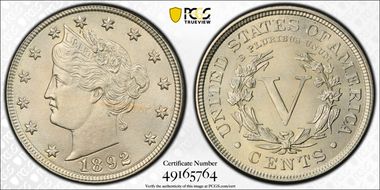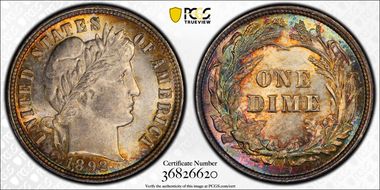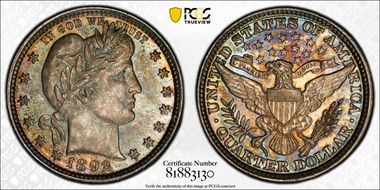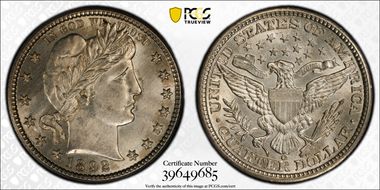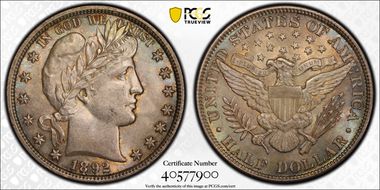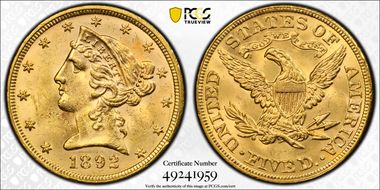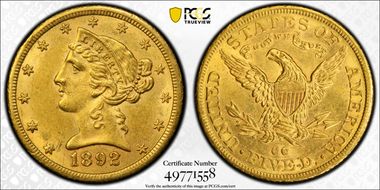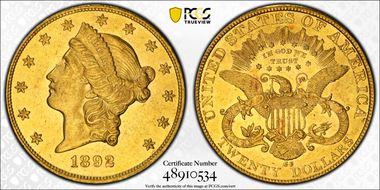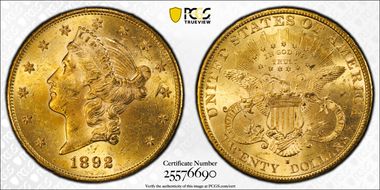Edward M. Paterson II (1892-1972) 的钱币相册
The mintage of the 1892 Liberty Head Nickel is thirty percent less than the preceding year, but the two dates are virtually equal in terms of the number of certified survivors. Both are common in Mint State up to MS-66, at which point the population drops off significantly. The finest 1892 Nickels certified by PCGS are two MS66s with the Plus designation. Generally, this date is struck well, but occasionally some of the stars may be weak.
The 1892 Dime is the first date of the new type designed by Charles Barber. As a result, many were saved by collectors as a novelty, so high grade examples are fairly plentiful today. Nearly 1,000 examples have been certified in Mint State. most appearing in the MS63 and MS64 grade levels. Even Gems are plentiful up to the MS67 level, where less than a dozen have been certified by PCGS. A look at the PCGS Condition census for this date shows examples with some spectacularly colorful toning.
By 1891, the old Seated Liberty design (with some modifications over the years) exceeded more than 50 years of service on some denominations. Thus, in 1892, the Mint introduced the new "Barber" design on Dimes, Quarter Dollar, and Half Dollars. The new design's nickname had nothing to do with hair-cutters, but was named after it's designer, Charles E. Barber. As they had done with previous new designs, the public grabbed up the new coins in large quantities, resulting in many high grade coins today. In fact, the 1892 is the second most common Mint State Barber Quarter according to the PCGS Population Report (as of August 2011), with a substantial lead over most other dates in the series. Not surprisingly, the only date with a higher population than the 1892 is the 1916-D, the last of the Barber Quarters (apparently, some collectors thought it, too, was going to be a rarity). Collectors of today can choose from a range of nice Uncirculkated grades, with the largest populations occurring in the MS-63 and MS-64 grades. MS-65 and MS-66 examples get a little scarcer, but they are not too difficult to find. In MS-67, the population declines rapidly, with less than two dozen examples in PCGS holders. The finest examples appear at the MS-68 level, where the single finest example is a lone PCGS MS-68+ (this remarkably toned example is illustrated above -- it is one of only three PCGS MS-68+ Barber Quarters in the entire series, with none finer).
The 1892-O Barber Quarter Dollar is in the middle of the pack in terms of mintage and overall rarity, and is in the lower half in terms of rarity in Mint State. This means that collectors should be able to obtain a high-grade example of this date with relative ease. Most Mint State 1892-O Barber Quarters cluster around the MS-62 to MS-64 grades, with MS-63 being the most common by a slight edge. MS-65 examples are scarce, but available. MS-66 and better examples are very rare, dropping to a mere three examples graded by PCGS in MS-67. The overall strike is good for a New Orleans Mint product, but still short of the well-made Philadelphia Mint issues. Some collectors pay attention to the placement of the mintmark on the back of Barber Quarters, partly out of interest, and partly as an aid in authentication. In 1892, mint engravers placed the mintmark over the R of QUARTER, unlike the placement on all subsequent years, when the mintmark appears over either the D of DOLLAR or between the R and D (the same is true for the 1892-S Quarter). Why the change was made is unclear, as the placement on the 1892-O and 1892-S Quarters centers the mintmark perfectly beneath the eagle's tail.
A new design appeared on Half Dollars beginning in 1892 and it was an immediate hit with collectors. Today, Population Report data confirms David Akers' old and long-held belief that the 1892 Half Dollar was the most common date of the series. No other date has a larger population -- some are close, but none can equal or exceed it. For today's collectors, this means there are numerous opportunities to acquire a high-grade example of this first-year-of-issue date. PCGS has certified literally hundreds of Mint State examples, mostly in MS63 and MS64. Moving up and through the Gem and Superb categories, we come to a single PCGS MS68 example, one of the finest Barber Half Dollars of any date. This colorful example has appeared at auction three times since 2005 and it set price records every time it appeared. For approximately half the price, collectors can opt for one of the lovely PCGS MS67+'s.
Once a rarity: From the time of mintage through the early decades of the twentieth century, the 1892 was a major rarity. Very few had been released into circulation. However, Proofs were available readily enough, and they took care of the need to acquire a circulation strike of the date. This situation was true of such other Philadelphia Morgan dollar dates as 1894, 1897, and 1899, among others. The relatively few transactions involving Mint State 1892 dollars sold prior to 1940 did not take place at high prices. Accordingly, the erstwhile rarity of this date was not recognized until I researched the matter in connection with the present text.
Hoard coins: When the Carson City Mint closed down, quantities of 1892-CC dollars were shipped for storage to the San Francisco Mint and, to a lesser extent, to the Treasury Building in Washington, D.C. From the San Francisco Mint, quantities were paid out over a period of years, including 1925-1926, but particularly in the late 1940s and early 1950s. Some bags, but probably not many, were dispersed from the Cash Room at the Treasury Department in Washington during the same time frame, up through 1950-1953. Then came a quantity dispersal. Dealer Steve Ruddel stated that about 50 bags (50,000 coins) of 1892-CC dollars were released from the Treasury Building in 1955 alone. (Reference: His advertisement in The Numismatist, January 1964.) Historically, the 1892-CC, like the 1990-CC and 1891-CC before it, was never considered to be a rare date. Enough were dispersed at or near the time of mintage that examples have been readily available on the market. However, in comparison to some of the 1878-1885 Carson City dollars sold by the G.S.A. in the 1970s, the 1892-CC is relatively elusive today.
Hoard coins: The 1892-O dollar has always been available in Mint State on the coin market. For example, in 1910 a specimen sold at auction at $1.25, a common-date price. Generous quantities were released at and immediately following the time of mintage. In later years enough remained in numismatic circles that dollar specialists always had them in stock. A few bags were released in the 1950s, from storage in the Treasury Building in Washington, D.C. However, the great deluge of this issue came during the unsealing in October 1962 of a vault in the Philadelphia Mint holding about 10 million Uncirculated New Orleans dollars. After that time, Harry J. Forman handled at least 20 bags and reported that the issue was very common in bag quantities, although the price never dipped much below about $5.00 per coin, and was more apt to be in the $7.50 to $12.50 range in the several years after 1964. Just before the October 1962 release, a typical Uncirculated coin was worth about $15.00. The Redfield estate, auctioned by the Reno Probate Court in 1976, is said to have had two to four bags, with the coins heavily damaged by a counting machine used during the pre-auction appraisal. In 1977 a bag from another source, said to have contained numerous gems (see below), was dispersed. In the 1980s, Bowers and Merena Galleries handled a bag of 1892-O dollars from a Pennsylvania estate. Most coins in the group were in the range of about MS-62 to MS-63.
The 1892-CC is one of the most common CC-Mint Half Eagles, and it is far less common than the 1891-CC. Less than twenty percent of the examples certified by PCGS are Mint State, and most of those are either MS62 or MS63. The low grades are usually the result of excessive bagmarks, caused by careless conveyance as they travelled cross-country. The very best example is an NGC MS66, believed to be the former PCGS MS65 from the 1/1990 Superior sale, where it set a record price that has not yet been beat The 1892-CC is one of the most common Carson City Half Eagles and is approximately equal in overall rarity to the 1882-CC, 1890-CC and 1893-CC. It is decidedly more rare than the relatively common 1891-CC. Although uncirculated examples are occasionally available, VF or EF specimens are the most often encountered. Choice or gem quality pieces are rare and are seen less often than comparable quality coins dated 1890-CC or 1893-CC.
The 1892-S is scarce as a date and rare in strictly uncirculated condition. Most known specimens are well worn and grade in the VF to EF range and choice quality mint state pieces are very difficult to obtain.
The 1892-CC is a scarce but not rare coin. It is a little more rare than the lower mintage 1893-CC in terms of population rarity and it is considerably more rare than the 1893-CC in Unc. The 1892-CC is usually seen in EF or AU condition although there are numerous VF examples around as well. Average uncirculated (MS-60) specimens are scarce but can be located without a great deal of difficulty. Choice quality uncs are very scarce and true gems are rare. This is another date that was considered quite rare in Unc. until the 1960's when many turned up in Europe.
The 1892-S is virtually identical with respect to both population rarity and condition rarity to the 1893-S. It is also very similar to the 1885-S, 1888-S, 1901-S and 1905-S except that it is more common than any of them in Unc. The 1892-S is more rare than the 1891-S as well as any of the S-Mint Double Eagles from 1894-1907 except the 1901-S and 1905-S. Average quality uncs are not difficult to find. Gems are very scarce but I have seen a number of them as well as a few truly superb quality specimens.




















